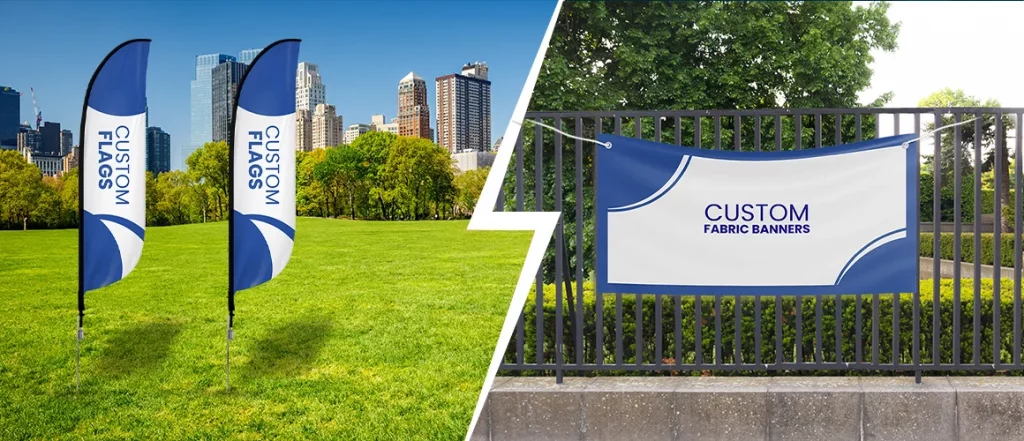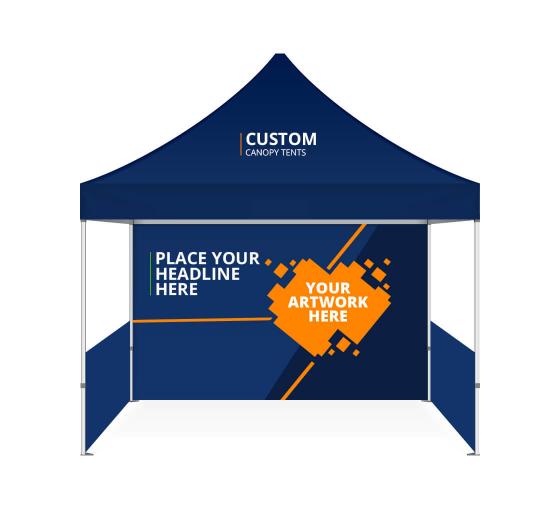Flag vs Banner has been a long-debated discussion. Although they both stand out as highly versatile advertising tools in the market, there are some differences that one ought to be aware of. They seamlessly adapt to both indoor and outdoor settings, affixing to flat surfaces and poles alike, and can even be propped up using stands. Certain types of flags even offer a see-through quality. Given the ability to print a wide range of images, the possibilities for marketing applications are virtually limitless. With such an array of options and formats available, distinguishing between them can sometimes pose a challenge. While banners and flags share similar objectives, they do exhibit subtle distinctions.
To ensure that we select the optimal product for our specific requirements, we all need a little guidance. Let’s go through a comprehensive understanding of banners and flags, elucidating their characteristics and pinpointing the situations in which each excels. Flags and banners are both types of visual displays, but they have distinct differences in terms of their purpose, design, and usage. Here’s a breakdown of the key differences between flags and banners.
Message or Marketing Tool: What are the Basic Differences between Flags and Banners
Horizontal or Vertical Display: Custom flags are typically designed to be displayed vertically on a flagpole or mast. They are commonly raised on flagpoles and flutter in the wind. Banners, such as vinyl banner printing are typically designed to be displayed horizontally or vertically and are hung on walls, fences, or other structures. They don’t necessarily require a flagpole.
Symbolic Representation, Messages and Promotion: Flags often carry symbolic meaning. They can represent countries, states, organizations, sports teams, or causes. They are often associated with identity and pride. Custom banners are often used to convey messages, promote events, products, or services. They are common in advertising and marketing campaigns.

Distinction in Design: Flags, such as custom feather flags, tend to have specific designs, colors, and symbols that represent the entity they stand for. These designs are often standardized and recognized by a particular group. On the other hand, fabric banners are often used to convey messages, promote events, products, or services. They are common in advertising and marketing campaigns.
Indoor and Outdoor Usages: Flags, like teardrop flags, are commonly used outdoors, especially in public spaces, official buildings, and during events like parades and ceremonies. Meanwhile, certain types of banners can be used both indoors and outdoors. They can be hung in indoor spaces like conference halls, trade shows, or retail stores, as well as outdoor locations.
Special Features of Advertising Flags and Their Significance in Today’s Market
Flags are often associated with representing identity, pride, and symbolic meaning, and they are commonly displayed vertically on flagpoles. Many flags have specific guidelines for usage, including protocols for hoisting, lowering, and displaying them in certain contexts.
Historical and Cultural Significance: Flags can have historical and cultural significance. They often carry a sense of heritage and tradition, representing a nation’s history or the values of a particular group.
Formal and Official: Flags are often considered more formal and official symbols. They have been carrying the load of representing nations and organizations for ages. They may be used in diplomatic events, government buildings, and official ceremonies.
Patriotic or Nationalistic: Flags are commonly associated with patriotism and national pride. They can evoke strong emotions and a sense of unity among citizens.
Limited Customization: While flags, for example garden flags,manj can have specific designs, there may be limitations on altering their core symbols or colors to maintain their recognized identity.
Personalised Banners and their Marketing Scope in the Economy
Banners, on the other hand, are versatile displays used for conveying messages, promoting events, and advertising products or services. They can be displayed horizontally or vertically and are suitable for both indoor and outdoor settings.
Temporary Displays: Banners are often used for temporary promotions, events, or announcements. They can be easily set up and taken down, making them suitable for short-term displays.
Branding and Advertising: Banners are frequently used for branding purposes and advertising campaigns. They can display company logos, product information, and promotional offers.
Customization: Banners offer a high degree of customization. Designs can vary widely based on the intended message, and they can include text, images, graphics, and other visual elements.
Decorative Use: Banners can also serve decorative purposes, adding a festive or aesthetic touch to spaces. They are commonly seen in weddings, parties, and festive occasions.
Informative: Banners often convey information, such as event details, directions, or important announcements. They are a practical way to provide information to a large audience.
Conclusively, while both flags and banners are visual displays that convey messages or represent entities, flags tend to carry more symbolic, formal, and historical meanings. They are associated with identity and pride, often symbolizing nations, states, or organizations. Banners, on the other hand, are versatile tools for conveying temporary messages, promoting products or events, and adding visual interest to various settings.


 Posted in
Posted in 



